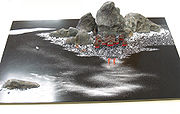
Bonseki
Encyclopedia

Bonseki is the ancient Japanese art of creating miniature landscapes on black lacquer trays using white sand, pebbles, and small rocks. Small delicate tools are used in Bonseki such as feathers, small flax brooms, sifters, spoons and wood wedges. The trays are either oval or rectangular, measuring about 60 by 35 centimeters in size. Oval trays have a low rim while rectangular ones are flat.
Bonseki scenes often depict mountains, seashores, and gardens. Small stones are used to represent mountains, shore lines or rocky islands that waves break upon. Miniature structures, usually of painted copper, are sometimes added to the work to make houses, temples, bridges, and the like.
Bonseki scenes by design are generally meant to only be temporary. Sometimes, by using special methods, a Bonseki scene can be preserved. This is called either Bonga ("Tray Picture") or Suna-e ("Sand Picture").

History of Bonseki
The origins of Bonseki are unclear but it is believed Emperor TemmuEmperor Temmu
was the 40th emperor of Japan, according to the traditional order of succession.Temmu's reign lasted from 672 until his death in 686.-Traditional narrative:...
, who reigned in the mid-7th Century, made use of Bonseki techniques to describe natural objects and landscapes. It is also believed that a number of gardens in Kyoto
Kyoto
is a city in the central part of the island of Honshū, Japan. It has a population close to 1.5 million. Formerly the imperial capital of Japan, it is now the capital of Kyoto Prefecture, as well as a major part of the Osaka-Kobe-Kyoto metropolitan area.-History:...
were planned and designed with the use of Bonseki as a type of temporary blueprint.
The c.1300 rhymeprose essay, Rhymeprose on a Miniature Landscape Garden, by the Japanese Zen monk Kokan Shiren
Kokan Shiren
Kokan Shiren , 1278–1347), Japanese Rinzai Zen patriarch and celebrated poet in Chinese, was the son of an officer of the palace guard and a mother of the aristocratic Minamoto clan. At age eight he was placed in the charge of the Buddhist priest Hōkaku on Mt. Hiei. At age ten he was ordained...
, outlines the aesthetic principles for bonseki and garden architecture itself.
Under the aesthetically-minded Shogun Ashikaga Yoshimasa
Ashikaga Yoshimasa
was the 8th shogun of the Ashikaga shogunate who reigned from 1449 to 1473 during the Muromachi period of Japan. Yoshimasa was the son of the sixth shogun Ashikaga Yoshinori....
(1443–1490), Bonseki became popular among members of the aristocracy. A century later, Sen no Rikyu
Sen no Rikyu
, is considered the historical figure with the most profound influence on chanoyu, the Japanese "Way of Tea", particularly the tradition of wabi-cha...
, the famed master of the Tea Ceremony
Tea ceremony
A tea ceremony is a ritualised form of making tea. The term generally refers to either chayi Chinese tea ceremony, chado Japanese tea ceremony, tarye Korean tea ceremony. The Japanese tea ceremony is more well known, and was influenced by the Chinese tea ceremony during ancient and medieval times....
, practiced Bonseki and one of his students, Hosokawa Sansai, set up a school dedicated to Bonseki with established techniques.
The Edo Period
Edo period
The , or , is a division of Japanese history which was ruled by the shoguns of the Tokugawa family, running from 1603 to 1868. The political entity of this period was the Tokugawa shogunate....
(1603–1867) saw many Bonseki schools set up as it gained in popularity. Bonseki was particularly popular with many ladies of the Shogunate court in old Tokyo
Tokyo
, ; officially , is one of the 47 prefectures of Japan. Tokyo is the capital of Japan, the center of the Greater Tokyo Area, and the largest metropolitan area of Japan. It is the seat of the Japanese government and the Imperial Palace, and the home of the Japanese Imperial Family...
.
With the restoration of Imperial rule, Bonseki declined sharply as more emphasis was placed on modernity and Western culture.
Modern Revival of Bonseki

In recent times, Bonseki has seen some revival as new groups continue to improve upon the Hosokawa techniques, while preserving its traditional elegance. One such group is the Tokyo Kuyo-Kai of the Hosokawa School. The Tokyo Kuyo-Kai is a group of students of the late headmasters of the Hosokawa school.
According to the Tokyo Kuyo-Kai group the object of Bonseki is not in the completion of the scene itself, nor in its preservation. The Tokyo Kuyo-Kai states: "The importance of Bonseki is the peaceful feeling and satisfaction you derive from creating a Bonseki scene and not the result of the work."
See also
- SandpaintingSandpaintingSandpainting is the art of pouring colored sands, powdered pigments from minerals or crystals, and pigments from other natural or synthetic sources onto a surface to make a fixed, or unfixed sand painting...
- Rhymeprose on a Miniature Landscape Garden
External links
- http://www.bonseki.org/page003.html A collection of links on other Bonseki sites
- http://www.bonseki.org Examples of Bonseki art and information (in Japanese) hosted by Tokyo-based Bonseki teacher, Mizutani Zuizan.
- Sekishu School of Bonseki Information in English about the school, includes pictures of the utensils used.
- Kiyohara school a school of bonseki
- Enzan-ryu a school of bonseki
- http://www.youtube.com/user/megumalion293]Youtube bonseki demo
- http://www.youtube.com/user/HosokawaryuBonseki]Youtube bonseki demo
- http://www.youtube.com/user/HosokawaryuBonseki#p/a/u/1/iWmzHVJG4FY]Youtube bonseki demo
- http://www.youtube.com/user/HosokawaryuBonseki#p/u/3/Tf21WWSs974]Youtube bonseki demo
- http://www.youtube.com/user/HosokawaryuBonseki#p/u/3/Tf21WWSs974]Youtube bonseki demo
- http://www.youtube.com/user/HosokawaryuBonseki#p/a/u/2/RNlBvZQSQkI]Youtube bonseki demo

